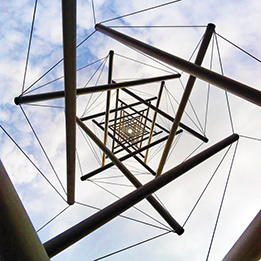 Spring 2014
Spring 2014|
“It’s in dialogue with the movement around it at the museum—cars circling it, people walking around it— and in some ways it takes on that energy and also holds its ground.”
- Dan Byers, The Richard Armstrong Curator of Modern and Contemporary Art |
The Science of Sculpture
Artistic pioneer Kenneth Snelson has made a career of straddling art and science. Last March, a longtime fixture of downtown Pittsburgh’s Mellon Square Park was removed in order to return the downtown plaza to its original landscape design. The 18-foot-tall and 35-foot-wide steel tube-and-cable artwork, named Forest Devil by sculptor Kenneth Snelson, was among the park’s dominating features for 35 years. But after weeks of conservation and meticulous reassembly, Forest Devil found a fitting new home. In a stretch of grass outside Carnegie Museum of Art’s rear entrance, the sculpture, acquired by the museum in 1978 with support from its Women’s Committee, was installed just in time to greet visitors to the October opening of the 2013 Carnegie International. “Forest Devil’s former location was very dynamic and interesting in the way the sculpture interacted with that beautifully designed public square,” says Dan Byers, the museum’s Richard Armstrong Curator of Modern and Contemporary Art. “But having the work come to the museum has been particularly exciting because the scale of the work comes into its own.” In its original location, Forest Devil was situated on an elevated expanse of Mellon Square, somewhat obscured from street view yet at the same time “dwarfed” by the tall buildings around it. At the museum, Byers says, the “dynamic, force-filled” sculpture, considered to be one of Snelson’s masterworks, has a presence it was previously denied.
“It’s in dialogue with the movement around it at the museum—cars circling it, people walking around it—and in some ways it takes on that energy and also holds its ground,” says Byers. “It’s a still point in a moving world, and it’s that tension between stillness and movement inherent in the work that makes it so interesting in its new space.” Weighing in at about 1,500 pounds, Forest Devil is composed of stainless-steel tubes and aircraft cable. Much of the material was donated by Allegheny Ludlum Steel Corporation as part of a 1978 citywide public arts project that paired internationally recognized artists like Snelson with local industrial manufacturers. The sculpture was also fabricated locally by Pittsburgh-Des Moines Steel Company and Colonial Machine Company. Typical of Snelson’s large, outdoor steel sculptures, Forest Devil fulfills what the artist calls a “constellation of form.” All parts of the sculpture are necessary to its structure. “Every cable has to be there,” Snelson says. “Every tube has to be there. There’s no redundancy. “Exposing myself as an artist has been in the pursuit of understanding the nature of structure,” continues Snelson, whose largescale, minimalist sculptures appear to climb into thin air at improbable angles and simply float. “What are the minimal circumstances that allow forces—push and pull—to organize a particular space to form a structure?” Works such as Forest Devil are not made by threading wires through struts or welding components together. Rather, they’re created through an alternating push and pull of struts against tensed wires. This structural principle known as “tensegrity”—an amalgam of “tension” and “integrity” first demonstrated by Snelson and later coined by his then-professor Buckminster Fuller who the artist says appropriated the idea as his own—designates a mutually supportive closed system. But despite their proximity to engineering and mathematics, Snelson says his sculptures are experiential not formulaic.
“I work by building models with my hands in order to develop the form as well as to verify how the forces perform, not by applied mathematics,” says the artist, who will give a free talk at the Museum of Art on April 10. Snelson starts with a model in miniature that he constructs out of anything from chopsticks and rubber bands to soda straws and string. Once completed, a “tensegrity” structure will not relinquish its form. It may be “squashed down,” Snelson explains, but it will always “pop back up” without sacrificing its structural integrity. “Some of my sculptures are completely non-narrative—that is, they are configurations in geometry,” he says. “Forest Devil is among those that present themselves as a creature of some sort, with a posture and an attitude.” With a career that has spanned more than half a century, Snelson has designed and produced dozens of large-scale public sculptures all over the world. The 60-foot-high Needle Tower at the Hirshhorn Museum and Sculpture Garden in Washington, D.C., is among his most widely recognized creations. He’s also given life to many smaller sculptures, photographs, computer renderings, speculative works, and even a handful of patents. In 1999, he was honored with the Lifetime Achievement in Contemporary Sculpture Award from the International Sculpture Center. The sculptural style that Snelson developed as a result of his education at Black Mountain College in North Carolina, where he studied with Fuller, explores the “inherent behaviors of materials,” says Byers. “His work is a real crossover between engineering and architecture and sculpture.” “The fundamental principle [of tensegrity] has confused some people in the art world because it appears to people as being too close to engineering,” says Snelson. “There’s a stigma often attached to artists whose work appears to be too close to science. My structural interest has made some people enthusiastic about my work and some people frightened. But my education and sensibilities are those of an artist.”
|
Unraveling Race · Silver & Suede · The Tedious Intrigue of Art Conservation · Sun Struck · President's Note · NewsWorthy · Face Time: Nicholas Chambers · Science & Nature: Nature as Classroom · About Town: Friends of the Forest · The Big Picture
 |
Copyright © 2017 CARNEGIE Magazine. All rights reserved. |


